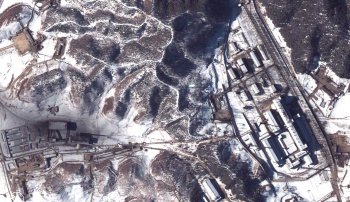|
Tensions
Rise Over North Korea's Nuclear Complex
Paraphrased by
Steve Waldrop
February 27, 2003
Seoul, South Korea-
U.S. spy satelites have recently detected smoke rising from the once shuttered
buildings around a loop of North Korea's Kuryong River. Trucks are seen
arriving and departing, and workers are seen everywhere.
 The
Yongbyon Nuclear Center is one of the most heavily guarded areas in one
of the world's most secretive and secluded nations. Located only 50 miles
from the North Korean capital of Pyongyang . It has become the focal point
of rising tensions over North Korea's nuclear weapons program. The
Yongbyon Nuclear Center is one of the most heavily guarded areas in one
of the world's most secretive and secluded nations. Located only 50 miles
from the North Korean capital of Pyongyang . It has become the focal point
of rising tensions over North Korea's nuclear weapons program.
American analysts
aren't sure what is going on there, and some South Korean experts think
the North is staging phony activity as a bargaining tool in its effort
to get Washington to sign a nonagression treaty. But movement at the site
has increased anxiety over the North's intentions.
Nations close by worry the North may be resuming its program to produce
nuclear weapons, fearing that could bring an arms race in the region or
even war. The face off also has caused some strain between Washington
and South Korea's government over how to deal with the crisis.
Experts believe the complex is home to 8,000 spent nuclear fuel rods that
could be processed within a few months into enough weapons-grade plutonium
for several atomic bombs.
"The moment they remove those rods for reprocessing will be the moment
they cross the danger line," said Paek Hak-soon, a North Korean expert
at Seoul's independent Sejong Institute. "Whatever they do at Yongbyon
will be carefully calculated and choreographed."
U.S. officials said satellite images caught covered trucks apparently
taking on cargo around the fuel rod storage facility, but
they were divided over whether the North Koreans were really removing
rods or just bluffing.
"They are just putting up a Potemkin village," said Kim Dong-Kyu,
an analyst at Seoul's Korea University, referring to a showy facade intended
to divert attention. "They know they are watched by satelites."
Paek also doesn't think the North Koreans are reprocessing fuel rods.
He said the next step would be for North Korea to restart the site's nuclear
reactor, which can produce more spent fuel rods.
"They will save
reprocessing the spent rods as an option they can use at a more critical
time, like when the U.N. Security Council tries to impose economic sanctions,"
Paek said.
|

